White Pitbulls
October 21, 2021 2021-10-22 14:51The term “Pitbull” is a bit confusing. If we’re using the strict definition, only American Staffordshire Terriers can be correctly called “pitbulls.” These dogs can come in any color, though all-white is not encouraged due to potential health problems.
Even if a dog is all white, it can be registered as an American Staffordshire Terrier, though. This isn’t seen as a disqualifying defect.
The American Kennel Club did not recognize these dogs until 1969, though the dogs had been in America since before the 1850s. The United Kennel Club recognized the breed much earlier in 1898, though the breed was primarily developed in the states.
While this dog has a somewhat negative reputation, they are not typically considered aggressive. They are extremely friendly and act very similarly to other terriers. They are bigger than other terriers, which makes their exuberant behavior a bit more challenging to handle.
These dogs are incredibly people-oriented, no matter what color they come in. They love their families – and pretty much everyone else too. Their overly friendly nature means that they are often very poor watchdogs, despite their reputation.
You can find these breeds very easily from breeders, shelters, and rescues. They are one of the most common dogs in the United States. However, people don’t always quite understand what they’re getting into with this breed.
They are not low-maintenance in the least. They require significant amounts of exercise to remain calm and plenty of training – which isn’t always straightforward for this breed.
If you do correctly care for this dog, they can make great family animals.
Table of Contents
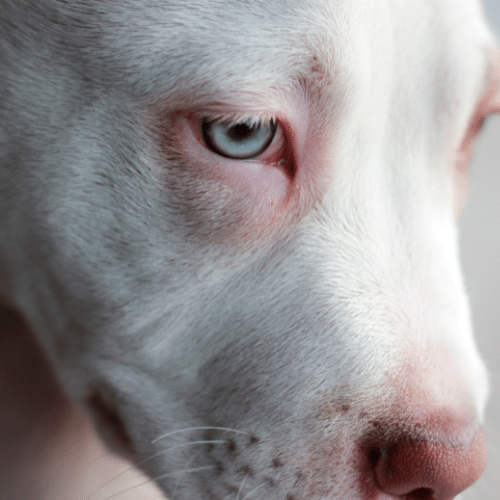
Appearance
Overall, white Pitbulls are precisely like any other Pitbull – except they are entirely white. Their nose, lips, and paw pads are typically brown, though the exact shade varies considerably. Typically, their eyes are blue or light brown.
There is a lot that affects eye color. Coat color does seem to have some effect. Lighter-colored Pitbulls have lighter-colored eyes in most cases. However, that does not mean that all white Pitbulls will have blue eyes. Light brown (and even dark brown to a lesser extent) are equally as possible.
Most puppies start with blue eyes, but they begin to darken as the puppy ages. Just because a white Pitbull puppy has blue eyes doesn’t mean they will stay blue into adulthood.
Pitbulls are medium-sized dogs. They usually stand at around 17 to 19 inches. Males are considerably larger than females, usually by an inch or two. A healthy Pitbull weighs between 40 and 70 pounds. Weight and height should be proportional.
These dogs have a smooth, short coat that doesn’t require a massive amount of brushing. Their grooming needs are pretty low when compared to other breeds because of this. However, they shed a decent amount, and the white hair can stand out on specific clothing and furniture.
They have relatively broad heads and very defined jaws. They’re powerful-looking dogs and can be highly muscular. Despite their broad shape, they are pretty agile and graceful in their mannerisms. They are very athletic dogs, and it shows.
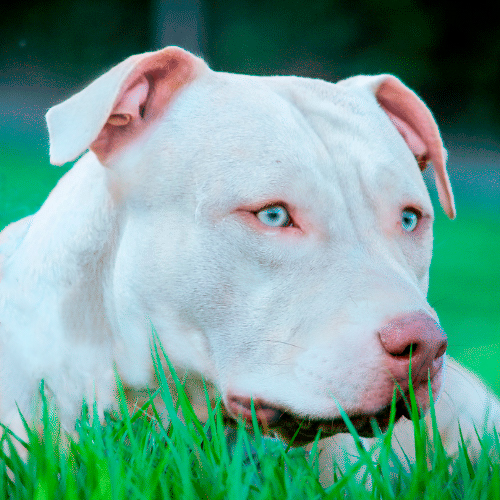
History
The Pitbull has a rather complicated history. They are descended from the Bull-and-terrier breed of the British Isles. This breed was the ancestor of many different modern breeds, including the Bull Terrier.
In some estimates, this type of dog found its way to America quite early – as early as 1850. In the Americas, these dogs were primarily used in dogfighting. In the British Isles, blood sports like bull baiting were already banned by this point, making the Bull-and-terrier a bit obsolete.
The breed was able to find a new foothold in America, though, as there was no legislation against dog fights and similar sports.
The Bull-and-terrier was quickly developed into a unique breed in America when the American Staffordshire Terrier truly came into being. In 1898, the United Kennel Club recognized this breed as its own, setting it apart from other bull-and-terrier-type breeds at the time. They named the breed the American Pit Bull Terrier.
In 1936, the AKC accepted a few of these Pit Bulls into their studbook. However, they didn’t like the name “American Pit Bull Terrier” since it was connected to the breed’s violent beginnings (aka pit fighting).
For this reason, they decided to name the breed the “American Staffordshire Terrier.” This name was based on the claim that the breed came from Staffordshire, England, though we know that this is not true today. The breed was placed into the AKC terrier group due to its ancestry.
UKC dogs were accepted into the AKC a few times over the next few decades. Therefore, the breed in both countries remained pretty similar for a while. However, the AKC has closed its studbook since the 1970s, so only puppies bred from other AKC Pit Bulls can currently be registered.
The breeds in both countries have departed somewhat for this reason. They are simply working with different breeding pools. There is still some confusion on whether the American Staffordshire Terrier and American Pit Bull Terrier are the same breeds or not, though. It mostly depends on who you ask!
This dog has begun to decline in popularity since World War II. Before then, it was one of the most recognizable American dogs around. However, many other breeds were imported to America after the war, which led to the downfall of many native breeds.
Personality and Temperament
There is a lot of misinformation about Pitbulls out there, including white Pitbulls. These dogs are often incorrectly seen as violent or overly aggressive. It has been the target of “breed bans” in many locations.
However, there is no evidence that this breed is any more aggressive than any other. A study done by the American Veterinary Medical Association has found that breed is not tied to aggression in any natural way. Training and socialization matter a lot more.
Any dog can become aggressive without the proper handling and socialization. If you never introduce your dog to strangers, they’re not going to react very well whenever you bring a stranger into your home.
The American Kennel Club describes these dogs as intelligent, friendly, and confident. They are extremely people-oriented and love just about anyone – family members and strangers alike. We don’t recommend Pitbulls as guard dogs for this reason.
A well-socialized Pitbull is more likely to lick someone rather than bite them – even if they’re a stranger breaking into your house.
They are loyal dogs that are very devoted to their owners and families. However, they are not territorial like some other breeds out there. They will follow you to the end – but they’ll happily take attention from a stranger as well.
For this reason, they are often seen as wonderful family dogs!
These dogs are often great with children. Their large size allows them to put up more disorderly behavior, and their fearlessness prevents fear-based biting, which is quite common in smaller breeds. However, they are pretty exuberant and are more likely to knock children down than most large breeds. Regular exercise and mental stimulation can curb this, though.
A tired dog is much less likely to take off running and knock someone over.
Training and Exercise Needs of a White Pitbull
Pitbulls are pretty easy to train – as long as you train them correctly. As devoted and people-oriented dogs, they are incredibly eager to please. They want to make you happy and will quickly follow commands to make that happen.
However, they are also distractible dogs. They don’t have the intense focus that many other breeds do. They aren’t German Shepherds or Poodles!
They can also be a bit sensitive. If they are trained harshly, they may stop listening altogether. Positive reinforcement training with lots of praise is often the best way to train these dogs.
They are pretty intelligent, so white Pitbulls can typically learn most commands with ease. But they aren’t so intelligent that they need constant mental stimulation. Often, companionship, regular training, and walks are enough to keep these dogs entertained.
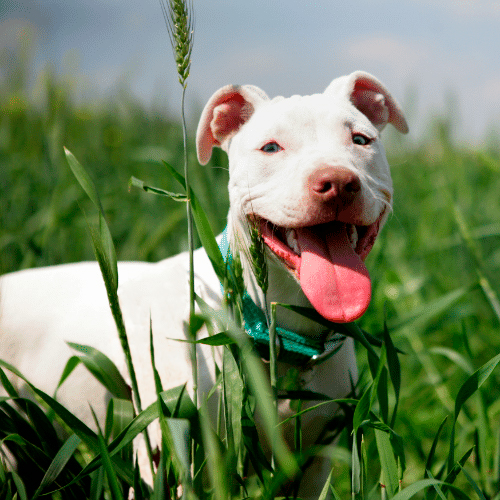
You can also invest in puzzle toys if your Pitbull is displaying some destructive behaviors. Typically, these behaviors are caused by boredom, which can be solved with mentally stimulating activities.
Pitbulls are highly active dogs, and white ones will be no different. We recommend these dogs for more active families, as they need quite some exercise to stay happy. You should plan on walking these dogs at least twice a day, though three times is often better.
When walking, follow your dog’s lead on the length and distance they walk. You don’t want to over-exercise your dog, as this can cause joint problems – especially if you’re walking on an inclined, paved path.
Schedule in time to sniff as well. Walks shouldn’t just be about getting from point A to point B as quickly as possible. Sniffing is very mentally stimulating for dogs.
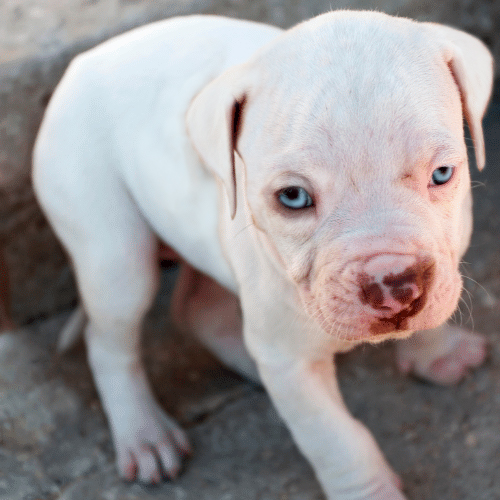
Health and Care
Pitbulls are a pretty healthy breed. They were bred for practical purposes – not for looks. Therefore, they often don’t suffer from the same health problems that other breeds do.
With that said, they are prone to a few different conditions. Owners need to be aware of these concerns. Some of the health problems below can be avoided with proper care or health testing. Others can be managed much better if they are caught early, which is easier to do if you know what symptoms to look for.
Common Health Issues
When possible, you should adopt your Pitbull from a reputable breeder to avoid genetic health problems. On top of only healthy breeding dogs together, a qualified breeder will also perform the required health testing to keep these dogs from inheriting certain medical conditions.
If you want to have a healthy white Pitbull, adopting from a breeder is required. A puppy may be more expensive this way, but you’re getting a lot more bang for your buck. Puppies from breeders are expensive because they put plenty of extra work and time into their litters.
Allergies
Allergies are a common problem with this breed. For the most part, these allergies are linked to food. Despite what you might think, food allergies often display themselves as skin problems. The dog will become itchy around its paws, leading to excessive grooming.
It isn’t uncommon for dogs to bite and lick their fur and sometimes even their skin. After they’ve opened sores, secondary infections can set in. These infections make the skin even itchier, leading to further scratching and licking. Eventually, these infections can become quite serious – sometimes even fatal.
We highly recommend working with a vet to determine the cause of your dog’s allergy. The dog’s food will often need to be switched to something that doesn’t contain its allergen. Allergens are usually a form of animal protein, such as chicken or beef. If your dog is eating a single-protein food, the primary protein source is likely the cause of the allergy.
The only way to manage allergy problems in dogs is to avoid their allergen. They will need to be placed on exceptional food for the rest of their lifetime.
Urinary Tract Infections
For one reason or another, Pitbulls are somewhat prone to UTIs. Usually, the first sign of a UTI is improper urination in the house. If your dog suddenly starts having accidents, it might not be just because they’re a bad dog. They may have an infection!
These infections are relatively common in most dogs. It isn’t odd for dogs to get them now and then – no matter their breed. Pitbulls just seem to get them more often than other breeds.
Urinating becomes painful for dogs when they have an infection. Some dogs may hold their urine and then have significant accidents inside. Others may not hold their urine much at all, leading to more minor accidents more often. Some may leak in their sleep or when relaxing. Dogs can also act like they’re urinating but then not have anything come out. Typically, this is associated with a more severe infection.
The urine typically develops a more pungent odor, which is easy to recognize when the dog is urinating in the house.
If a UTI is not treated, it can turn into a bladder infection. Some dogs may also develop bladder stones alongside a UTI, causing extra health complications.
Luckily, this condition is easily treated with medication. You simply have to take your dog to the vet for a prescription!
Autoimmune Disorders
Autoimmune diseases occur when the white Pitbull’s immune system begins attacking native cells. Typically, the immune system is supposed to attack invading cells, like bacteria and viruses. However, it can sometimes get a bit confusing and attack the body’s cells as well.
No one exactly knows what causes these conditions. Usually, the immune system only attacks a certain kind of cell. It is theorized that genetics may play a role, but so may environmental factors. Currently, we just don’t know.
Autoimmune diseases are usually not curable. You can’t tell the immune system to stop attacking. Treatment usually involves fixing the damage the immune system is doing, slowing down the damage, or replacing the hormones that have been disrupted. It depends on your dog’s symptoms and the exact type of disease.
Congenital Heart Disease
This category of heart disease occurs during the development of the puppy. For one reason or another, the heart does not develop correctly as the puppy grows inside the womb, leading to a heart condition.
Many of these conditions are genetic, which means that they are inherited. Usually, this involves recessive traits, so both parents may be completely healthy. The puppy must inherit two genes to show symptoms and malformations in growth.
Some of them may be due to unacceptable conditions in the womb, though. Environmental factors can affect a developing fetus, which can cause the heart to develop improperly.
In Pitbulls, there does seem to be a higher chance of genetic heart conditions. Genetic testing may help with some of these issues, but there are so many potential genes that it is impossible to avoid congenital effects altogether.
Sometimes, these heart conditions aren’t severe. Other times, they are. Some may not even be detected until the dog is much older, which makes breeding somewhat complicated.
Hip Dysplasia
Hip dysplasia is relatively common in larger breeds. It doesn’t affect the Pitbull as terribly as some other canines, but they can still be affected by it.
This condition is caused by improper growth in the hip joint. The ball and socket do not grow together correctly during puppyhood. One grows bigger faster than the other. This leads to a loose joint, which the body attempts to correct.
Typically, excess wear occurs, which leads to arthritis far before the dog is older. Symptoms usually occur before the dog is four, though the condition itself constantly forms in puppyhood.
Genetics do play a role. Some dogs just don’t grow properly no matter what you do. However, environmental factors can also play a role. Overfeeding or overexercising puppies can cause joint growth problems, leading to hip dysplasia.
Puppies often act like they are hungry all the time, mainly when they belong to a breed that’s as food-driven as Pitbulls. It’s essential that they are only fed precisely what they need, or they can develop severe problems with their joints and skeletal structure.
Grooming
White Pitbulls are extremely easy to clean. Their white coats show dirt and grime more than other colorations, but that doesn’t necessarily mean they need to be bathed or brushed more. You may notice it a bit more when you fall behind.
We recommend a quick brushing once a week with a soft bristle brush. White Pitbulls have very short coats, so you don’t have to worry about tangles or mats. However, a fast-brushing session helps remove dirt and grime that would have stuck to the coat.
These brushing sessions significantly elongate the time needed between baths, reducing possible skin irritation and drying.
Brushing also helps distribute skin oils throughout your dog’s coat. These oils help keep the coat clean, as they naturally repel dirt and grime. It also prevents the oils from sitting on the skin, where they can cause potential issues.
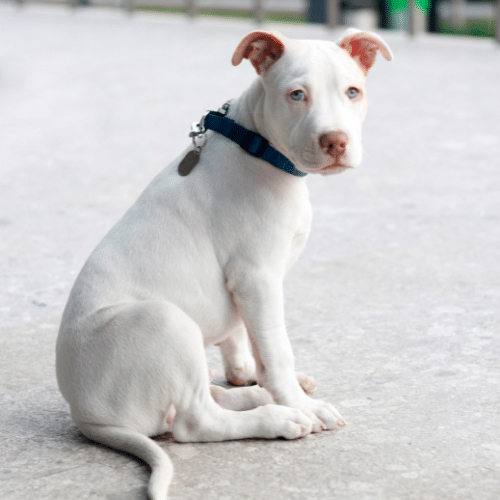
Bathing can typically wait until the dog gets smelly, which should be every few months or so. You shouldn’t bathe your Pitbull on a strict schedule, as overbathing can cause severe skin problems.
If your white Pitbull rolls in red mud, they’re going to need a bath! Otherwise, hold off as long as possible and use a sensitive skin shampoo when you do.
Adopting a White Pitbull
Pitbulls are pretty easy to find, despite their declining popularity. You can usually find them at shelters and rescues, though you may have to wait a bit until a completely white Pitbull shows up.
There are many breed-specific rescues spread throughout the country. These may be your best place to look for this specific coloration since they will likely have the most Pitbulls.
You can also check for local breeders near you. Typically, breeders don’t produce completely white dogs – or even dogs that are 80% white. It is discouraged by the American Kennel Club, as there are some worries about increased health problems.
However, that doesn’t mean there aren’t any breeders that breed white dogs. Many ignore the warning and do it anyway since the AKC doesn’t technically ban it.
When purchasing from a breeder, be sure to do your due diligence when it comes to research. You should be extremely careful with this breed since their genetics play a significant role in their temperament.
Be sure to ask about health testing. Professional breeders will health test any dog before breeding them to ensure that they aren’t a carrier for concerning medical conditions. Often, their hips are also scanned to check for hip dysplasia, which is genetically linked.
Experience Level for Owning a White Pitbull
We typically don’t recommend this breed for new dog owners. They are very exuberant and require a lot of physical exercise. As a more active breed, they simply require more work in general. Most new owners don’t understand what they’re getting into with this breed, which leads to many people adopting dogs they can’t properly care for.
This situation may be why so many Pitbulls end up in shelters and rescues. They may be advertised as “beginner” dogs, but they aren’t.
Due to their slightly larger size, this breed also needs a lot of training. They can quickly become out of control if they are not appropriately trained. It helps if you have at least some experience with training, though it isn’t necessarily required for this breed. They are pretty easy to train, allowing many new dog owners to get by as long as they work with a professional.
Pitbulls are typically quite friendly, so they don’t need the heavy socialization that some other dogs do. They also don’t have significant problems with territorial behaviors. However, that doesn’t mean that you can skip socialization altogether. It is still essential for this breed to be adequately socialized to avoid possible aggression problems.
If you never introduce your canine to strangers, you can’t expect them to react very nicely when you have a friend over years later! If they never interact with another dog, they likely won’t be accepting of other canines. They just don’t know how to interact with them.
This socialization is best left to someone with at least some dog experience. It is vital to their overall wellbeing, so there is little room to mess up!
The Bottom Line
White Pitbulls aren’t common, but that doesn’t mean they don’t exist. These canines are produced by some breeders and can often be found at rescues and shelters. The AKC does discourage completely white dogs, though. Therefore, many breeders don’t produce dogs that are over 80% white.
However, you can still find them. Some breeders specialize in mostly white Pitbulls, though they may cost a bit more than your average Pitbull.
With that said, these dogs are not for beginners in the least. They can be a bit overwhelming if you don’t know what you’re getting into before adopting them. Pitbulls are highly active dogs. They act similarly to other terriers in this way. However, they are much larger than most terriers!
You should plan on exercising your Pitbull multiple times a day. We recommend them for active families for this reason. Others may find it challenging to meet this dog’s exercise needs, resulting in destructive behavior.
They also need a fair amount of training, though they take to training quite easily!
White Pitbulls can make great family pets as long as you care for them properly.

Author: Kristin
Kristin was born in Tennessee and currently lives there with her husband and children. She is passionate about educating pet parents and helping them make the best possible decisions for their pets. She currently owns one dog, two cats, a lizard, and a variety of fish.

